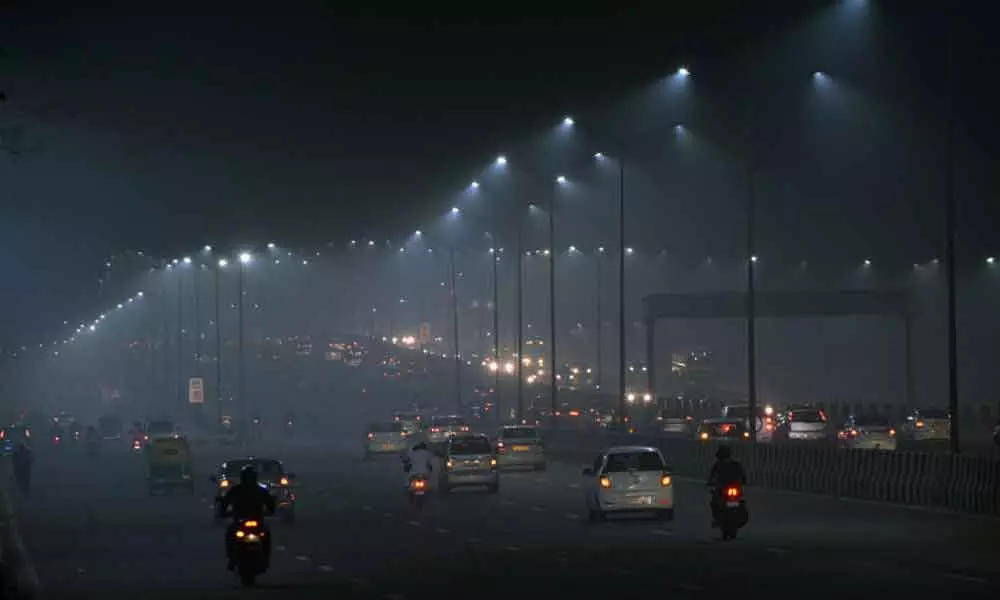Live
- ‘RAPO22’ launches with grandeur
- Drug abuse eating into vitals of our nation
- Sai Durgha Tej gets special gift
- They always want me to win, and now I feel lucky to have been offered a story like ‘Zebra’: Satyadev Kancharana
- ‘Democracy first, humanity first’: PM Modi in Guyana's parliament on two countries' similarities
- PKL Season 11: Telugu Titans register third straight win to top standings
- Is Pollution Contributing to Your COPD?
- NASA Unveils Underwater Robots for Exploring Jupiter's Moons
- Additional Central forces arrive in violence-hit Manipur
- AR Rahman and Saira Banu’s Divorce: Legal Insights into Common Issues in Bollywood Marriages
Just In

Delhi remained blanketed by a thick haze on Wednesday with its air quality dropping further, largely due to the heavy load of smoke from stubble burning in neighbouring Haryana and Punjab, according to government agencies.
New Delhi (PTI): Delhi remained blanketed by a thick haze on Wednesday with its air quality dropping further, largely due to the heavy load of smoke from stubble burning in neighbouring Haryana and Punjab, according to government agencies.
Weather experts said the problem aggravated due to unfavourable wind speed that lead to accumulation of pollutants. A relief is likely on the weekend, they said. The city's pollution levels peaked at 2 am, touching the 423 mark. The overall air quality index (AQI) oscillated between 410 and 420 during the day, according to data from the Central Pollution Control Board. Twenty-seven of the 37 air quality monitoring stations across Delhi recorded the AQI in the "severe" category. Anand Vihar was the most polluted area in the capital with an AQI of 464 and Wazirpur following with an AQI of 462. NSIT, Dwarka, was the least polluted with an AQI of 355.
Pollution levels in the satellite towns of Ghaziabad (478), Greater Noida (440), and Noida (451) were equally worse. An AQI between 0-50 is considered "good", 51-100 "satisfactory", 101-200 "moderate", 201-300 "poor", 301-400 "very poor", and 401-500 "severe". Above 500 is "severe-plus emergency" category.
According to the Ministry of Earth Sciences' air quality monitor SAFAR, the share of stubble burning in Delhi's pollution has risen to 35 per cent, the season's highest, and the hazardous haze shrouding the city on Wednesday can be "purely" attributed to it. Extremely calm surface winds on Tuesday night aggravated the problem, it said. Northwesterly winds, which are favourable for plume transport, will continue to blow in the region for another two days, it predicted. A marginal improvement in the air quality is predicted on Thursday due to an expected increase in wind speed which will help disperse pollutants faster.
On Thursday, the share of stubble burning in Delhi's pollution is predicted to be 27 per cent. It was 25 per cent on Tuesday. The city government has identified five "critically polluted" areas in the city after examining post-Diwali pollution data and asked municipal corporations and the Delhi Pollution Control Committee to intensify actions at these locations. The "critically polluted" areas are Wazirpur, Anand Vihar, Ashok Vihar, Vivek Vihar and Bawana.
Chief Secretary Vijay Kumar Dev took stock of the situation and asked the authorities to show zero tolerance towards violation of dust pollution control norms, and illegal dumping of construction waste and burning of garbage. In view of hazardous pollution levels in Delhi, doctors advised people to take a lot of precautions, including wearing face masks and avoiding early morning and late evening walks as concentration of pollutants is highest during this period.

© 2024 Hyderabad Media House Limited/The Hans India. All rights reserved. Powered by hocalwire.com







